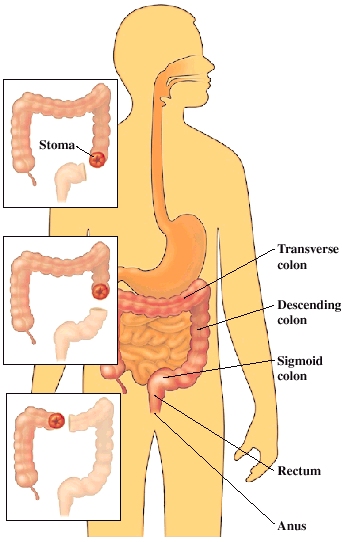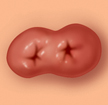What Is a Colostomy?
During a colostomy part of the colon (large intestine) is removed or disconnected. If the large intestine was diseased, it may be removed. If it was injured, it may be disconnected for a short time while it heals, then reconnected. During a colostomy, the colon is brought through the abdominal wall. This makes an opening, called a stoma, for stool and mucus to pass out of the body.

Types of Colostomies
The type of colostomy you have depends on what part of the colon is removed or disconnected. The most common types of colostomies are:
Sigmoid Colostomy
-
The last section of the colon is removed or disconnected. The rectum and anus may be removed, or they may be disconnected and left in the body.
-
The stoma is usually on the lower left side of the abdomen.
-
Stool is most often firm.
Descending Colostomy
-
The sigmoid colon and part of the descending colon are removed or disconnected. The rectum and anus may be removed or just disconnected.
-
The stoma is usually on the left side of the abdomen.
-
Stool may be almost firm.
Transverse Colostomy
-
All of the sigmoid and descending colon and part of the transverse colon are removed or disconnected. The rectum and anus may be removed or just disconnected.
-
The stoma can be in the middle or on the right or left side of the upper abdomen.
-
Stool varies from pastelike to almost liquid.
Types of Stomas
The stoma is created by bringing the colon through the abdominal wall and turning it back on itself, like a cuff. The stoma is pink and moist, like the inside of the mouth. It shrinks to its final size 6-8 weeks after surgery. The kind of stoma you have depends on your surgery. The most common types are:

An end stoma, most often done for a permanent colostomy. Stool and mucus pass from the same opening. If the anus is not removed, mucus passes from it as well.

A loop stoma, most often done for a temporary colostomy. Stool passes from one side of the stoma. Mucus passes from the other. The anus is most often not removed, so mucus passes from it, too.

Two stomas may be done for a temporary or permanent colostomy. Stool passes from one stoma. Mucus passes from the other. If the anus is not removed, mucus passes from it as well.












